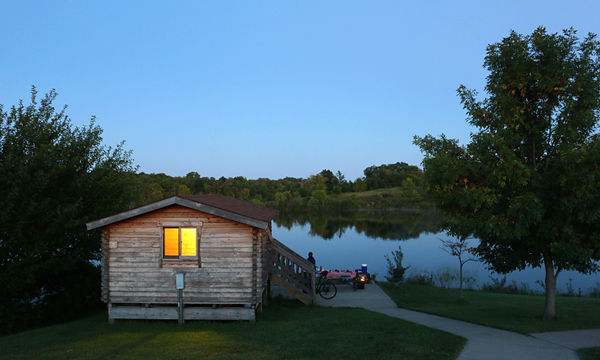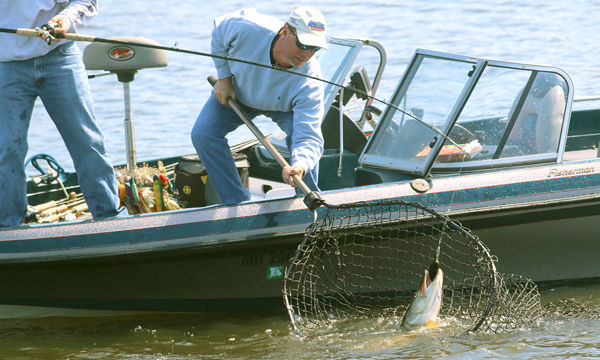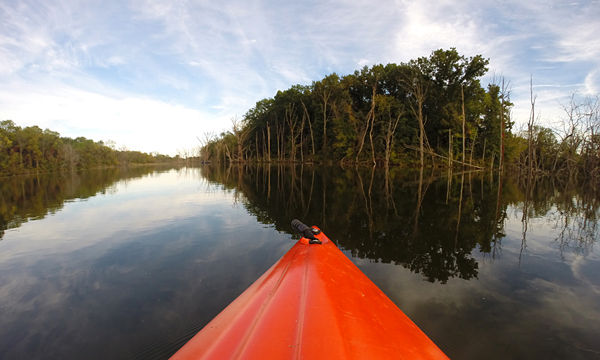- While groups of 25 or more are welcome and encouraged to use the park's facilities, they are required to register in advance with the site office to avoid crowding or scheduling conflicts.
- At least one responsible adult must accompany each group of 15 minors.
- Pets must be kept on leashes at all times.
- Actions by nature can result in closed roads and other facilities. Please call ahead to the park office before you make your trip.
- Remember: take only memories, leave only footprints.
Hunting
JEPC features hunting for white-tailed deer, wild turkey and mourning dove, as well as upland species (pheasant, quail, woodcock, snipe and rabbit), furbearers (raccoon, opossum, red fox, gray fox, striped skunk and coyote) and squirrels. Season dates and hours, permit requirements and other regulations are published in the Illinois Digest of Hunting and Trapping Regulations, available through the Department of Natural Resources.
Six sunflower areas are situated throughout JEPC to accommodate dove hunting. Wheat fields in these areas are burned to attract doves. Dove hunting for the first 5 days is by special drawing. The first five days the drawing is by permit from Springfield. Unfilled hunter quotas are filled by site drawing days 1-5. The site drawing occurs at 10 am daily.
The hunter check station, located in a former farmhouse on County Highway 11, handles all hunting administrative functions. All hunters should check Online for hunter registration and obtain a windshield card.
A lottery drawing is held at the JEPC site office to distribute non-resident archery deer permits for one-week seasons starting the last week of October through the third week of November. Applications must be received by March 31. The specific season dates are listed on the application. For more information on hunting, please review the Site Hunting Information.
Fishing, Boating, Canoeing
Sport fishing opportunities are available at JEPC at Gridley Lake (25 acres, opened 1998) Prairie Lake (210 acres, opened 2002) and Drake Lake (35 acres, opened in 2003). Several ponds within the site also have been renovated. Stream fishes include largemouth bass, bluegill and green sunfish, along with shiners, chubs and minnows. In addition, Prairie Lake is stocked with muskie.
Trolling motor and canoe access are allowed at Gridley and Drake Lakes. Prairie Lake has unlimited horsepower with a no-wake zone for the entire lake. Sail boats are allowed.
Picnicking
Picnic areas and restrooms are located at Gridley Lake, Drake Lake, Painter Pond, Geiss Pond, and the Prairie Lake day use area. Shelters can be reserved for a fee of $25 or, if not reserved, they can be used on a first-come, first-serve basis.
Biking
JEPC offers a 17-mile off-road biking trail as well as a 9 mile paved biking trail. The 17 mile off-road biking trail is located around Prairie Lake. Trails are closed until 1:00 p.m. during all turkey seasons and closed sunrise to sunset during the 7-day deer firearm season. The rolling scenic trail traverses forests and grasslands and has may overlooks along the lake.
Horseback Riding
A 22-car/trailer parking lot, along with a 26-mile trail, are located in the northwest corner of JEPC on Questing Hills Road just off County Highway 2. The site has an equestrian campground at Questing Hills, with 51 electric sites. A south access to the equestrian trail is found at Q-4 parking lot situated between the 9-mile north loop trail and the southern 11- and 6- mile loops. The trails are open year round with the following exceptions; trails are closed until 1:00 p.m. during all turkey seasons, closed sunrise to sunset during the 7-day deer firearm season and closed on Tuesdays and Saturdays during the upland game season. Call the park office before arrival to check for weather related closures.
Hiking
Off-trail hiking is available from parking areas positioned off public roads throughout the site. Because unmarked, open wells may exist in the area, caution must be used by individuals visiting JEPC.
A 3-mile hiking and jogging trail opened fall of 1999 around the lake shore at Gridley Lake. Seventeen miles of new hiking and mountain bike trail opened in 2001 around Prairie Lake. Seven more miles of mountain bike/hiking were opened in 2003 around Drake Lake and connecting to the Prairie Lake trail. There are 26 miles of equestrian trails in three loops. The trails have a lot of elevation changes.
Camping
There are a variety of camping opportunities at JEPC. Prairie Lake Campground has 84 sites, 19 of which are full hookup sites with sewer drops and water at the sites. The other sites all have electricity. There are also nine rent-a-cabins located in the campground. The cabins are located on the shore of Prairie Lake. The cabins have two rooms with the back room containing two bunk beds. The front room has a double bed, drop down table and a couple of chairs. All beds are equipped with mattresses, but you must bring your own bedding (no cooking or smoking inside the cabins). A concrete patio outside each cabin has a grill/fire pit and table. All cabins have electricity, ceiling fans, and a 1000-watt heater. The site also has an equestrian campground, Questing Hills, with 51 electric sites.
A Class AA campground has 18 sites that have sewer drops and water hookups at the sites and an additional 64 class A sites. A new shower building is available.
A primitive camping area at Jim Edgar Panther Creek has seven three-sided shelters to camp near or in for a fee of $6 per night. Hikers and mountain bike riders must travel approximately a quarter mile from the nearest parking lot to access the shelters. Reservations for campsites, cabins, and picnic shelters may be made at ExploreMoreIL™
Day Use, Archery Range
The park has shelters in the following day use areas: Prairie Lake (with fireplace), Gridley Lake, Geiss Pond, Painter Pond, and Drake Lake. These areas may be reserved for a $25 non-refundable fee through ExploreMoreIL™.
The Chuck Farmer Memorial Archery Range is conveniently located along Prairie Lake, with the shotgun range just down the road. Both ranges are open from dawn to dusk year round, except for during firearm deer season. The shotgun range is closed during IDNR Wingshooting Clinics, and is only for shotguns and targets. No slugs or rifles allowed, only shot shells.
History
Settled and farmed by the mid-1800s, the contiguous farmsteads that composed Jim Edgar Panther Creek were purchased from 1968-1974 by Commonwealth Edison for development of a coal-fired, electric-power generating plant and a 5,000-acre cooling lake. The company named the 16,550-acre tract "Site M" for nearby Menard County, where coal to fuel the power plant was to be mined.
Commonwealth Edison leased about half of the acreage for cropland, and through a cooperative agreement with the IDNR also provided limited upland and forest game hunting. Through the years, hunters applying for permits to the area became well-acquainted with the Site M name.
Commonwealth Edison abandoned its plans to build a power plant at Site M in the 1980s. By virtue of its size and location, Site M became an unparalleled opportunity for the IDNR to address critical conservation needs and meet outdoor recreation demands. With funds specifically designated for conservation purposes, the State of Illinois added the acreage to the public trust in June 1993, making Site M the largest tract ever acquired by the IDNR at that time.
Effective January 1, 2001, Panther Creek Conservation Area was absorbed into JEPC in an effort to avoid confusion and simplify site regulations. This brings the total acres of JEPC to 16,550. Panther Creek CA is now known as the West Open Unit.
Conservation Efforts
Forests, confined primarily to steep terrain, cover 6,000 acres of JEPC. Common hardwood species include American elm, black walnut, black cherry and several types of oaks, including white, black and bur. Because the timberland was affected by extensive logging and grazing through the years, the Department is managing this area to enhance its forest wildlife habitat.
Scattered pockets of wetlands at JEPC are associated with upland depressions, farm ponds and drainage ways. Common plants in these areas include long-leaved and horned pondweed, duckweed, rice cutgrass, reed canary grass and bulrush, as well as black willow. A severely degraded segment of Cox and Panther creeks, near their confluence in the northwestern portion of the site, has undergone stream bank stabilization and is part of a model watershed project to improve the Illinois River system.
Because agriculture on a lease basis is an integral management component for conservation and fiscal purposes, about 4,200 acre of JEPC are leased as cropland to farmers using conservation-oriented agricultural practices.
Two man-made wetlands were constructed in 1999 as part of the road construction project. Since 1993, when the state began to manage the area, 1,200 acres of native grass, 820 acres of cool season grass, 180 acres of habitat strips, and 105 acres of trees have been planted in land that once was agriculture fields or pasture. An additional 670 acres have been idled and allowed to move towards forest through natural succession.
Natural Heritage
An outstanding example of the original loess hill prairies of central Illinois is JEPC's Cox Creek Hill Prairie Natural Area. The 175-acre site encompasses remnants of scattered hill prairies composed of loess (windblown silt), which occur within forest openings on steep terrain where soils are droughty and well-drained. Among the plant species found on loess hill prairies are little bluestem, side-oats grama, fringed puccoon, wild petunia and prairie dock.
Several rare Illinois plant species grow here. The small white lady's-slipper orchid has state-endangered status, while four other plants are listed as state-threatened species: savanna blazing star, pale false foxglove, large-seeded mercury and Hill's thistle.
Surveys have identified 87 species of breeding birds here as well. Among the notable residents are eastern bluebird, orchard oriole and lark sparrow, plus 11 warbler species, five types of woodpecker and three species of owl. Loggerhead shrikes, a threatened species in Illinois, have been observed at the site, as have endangered northern harriers and red-shouldered hawks.
Directions
Located in Cass County 25 miles northwest of Springfield off State Illinois Route 125, 10 miles northeast of Virginia, 10 miles west of Petersburg and New Salem State Historic Site, and 10 miles northwest of Ashland.





